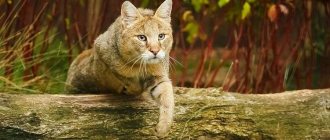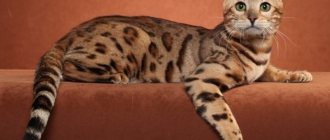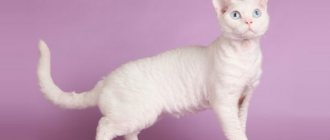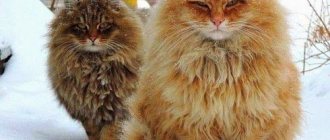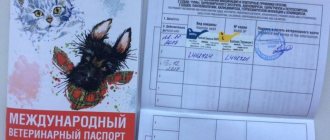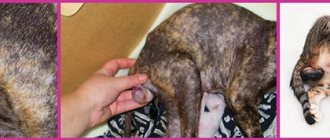Coat and color are a distinctive feature of the Bengal cat. Each pattern is individual: spots or stripes on a cat are like fingerprints on a person; no two are alike. Today, there are many colors of Bengal cats. The Snow Bengal stands out among all of them; it is even sometimes confused with another breed. Every cat lover dreams of having a little “leopard” at home.
Color standards
Outwardly, the Bengal cat always resembles its wild ancestors. On the muzzle there are contrasting dark stripes that resemble the letter “M” on the forehead. Light-colored whisker pads. The contours of the nose, lips and eyes are black or darker. Dark stripes on the neck, like a necklace, decorate it. There are often small stripes on the paws, but there may also be spots. The tail is also spotted or rosette, but its tip always remains black. All breeders strive to get as close as possible to the appearance of a wild cat. Therefore, the spotted belly and chest should preferably be lighter. It is not always possible to achieve such selective lightening - scientists still cannot definitively determine the gene that is responsible for this.
The colors of Bengals are distinguished by the color of the background and the type of pattern that is located on it. The most common are gold and silver backgrounds. There are snow bengals, among which there are lynx, mink, and sepia. The charcoal color is considered more rare. The blue color is also officially recognized.
Pattern: spotted or marbled
Cat coloring is divided into two types:
- Spotted (from English spotted) or rosette (from English rosetted) pattern. In the first case, these are solid spots. In the second, the so-called sockets. The color inside the rosette should be darker than the background, which is completely or partially surrounded by a darker circle (closed and open rosette). The size of the spots or rosettes can range from small to large.
- Marble (from English marbled) pattern: represents various horizontal stripes. Circular or vertical marks are faults. It is more highly valued when the marble pattern of the Bengal contains three colors: the background shade, the pattern and its edging.
To distinguish the colors of Bengal cats, it is easier to use the table:
Snow Bengal
Snow color is one of the rare ones. Snow Bengal kittens are divided into three groups depending on their genotype.
Links (Ben n 33) The background is represented by shades of cream or ivory. The pattern varies in tones of brown from light to dark. The head and paws are darker than the body. The tail is brown. These are the only snow bengals that are born completely white, and the pattern does not appear until they are one year old.
Mink (Ben n 32) They are often confused with the link color. The drawing from birth practically merges with the background and is hardly noticeable. The main difference is the eyes: their color varies from bright green to blue.
Sepia (Ben n 31) The color is lighter than golden, but darker than other snow Bengal cats.
The difference between the background and the picture is small. The pads on the paws are brown, as is the tip of the tail. Eye colors include variations of green and yellow.
What does the price depend on?
First of all, the main component of prices is the pedigree of the cat ; the more intense the color of the leopard, the higher the price. The age of the cat also plays an important role. Kittens are much more expensive than adults. This is due to the fact that it is easier to train a kitten and bring it closer to its way of life.
It is worth saying that the kitten is ready to move to a new place at the age of 3-4 months, not earlier. In order to avoid problems in the future, it is necessary to conclude a purchase and sale agreement between the seller and the breeder; along with the agreement, the buyer receives all relevant documents, including a pedigree (if any).
The price also largely depends on the class of the animal; the lower the class of compliance with all parameters, the lower the cost. The class is determined by several parameters, such as color, breeding stock, difficulty of care, health, and so on.
Mixed bengal cat
Bengals are prohibited from crossing with other cat breeds. This is fraught with sick or completely non-viable offspring. However, some engage in this activity for commercial purposes. Such kittens can be found through frequent advertisements on the Internet. We warn you! Mixed breeds of the Bengal cat are not officially recognized. Such kittens do not belong to the Bengal breed. As a result, you can get a kitten that will not meet external standards, but also its character. Breeders carefully select affectionate and non-aggressive representatives. Otherwise, the genes may take over and you will end up with an uncontrollable animal. Long-haired mixed breed (cashmere bengal, silk bengal) is gaining popularity. The animal has a similar color. It is distinguished by a fluffy tail, a “collar”, and longer hair on the sides and back.
Breed history and genetics
In order to understand the nature of the Bengal variety of colors, it is necessary to delve a little into the history of this breed.
Also read the article about Bengal cats on our portal.
The fact is that this is the first hybrid variety of domestic pets, obtained by crossing domestic and wild cats, in this case, initially the Egyptian Mau and the Asian Leopard Cat (ALC), which is also called the Lesser Asian Leopard, despite its very small size.
The first hybrid females of the future Bengals were Millwood Praline, Millwood Pennybank and Millwood Rorshack, from which, in fact, all 250 thousand animals of this breed registered today in the world originated.
All of them were bred by Willard Centerwall in his Loma Linda University laboratory. Dr. Centerwall created and left to the world an enormous legacy of diverse research and discoveries. Bengal cats are rightfully mentioned in the outstanding biography of this man.
This story began in 1980 and was started by the American Jeanne Mill. At this time she did not have ALC, but not for the first time she turned to the idea of creating a domestic cat that would be similar to the Leopard. She first crossed a domestic cat with an Asian Leopard Cat (Prionailurus bengalensis) in 1963.
The passage of the Endangered Species Act of 1973 and the listing of the Asian Leopard Cat on the accompanying U.S. Endangered Species and Wildlife List on June 14, 1976, ended the unregulated importation of ALA and other wildlife into the United States.
Public attitudes towards wildlife were changing, making the desire to live with a pet “leopard” increasingly popular, with increasing recognition that such a situation was not ideal for the wild animals and, perhaps, for neighbors.
Dr. Willard Centerwall was known to Jean Mill and others who were interested in the hybridization of domestic and Asian Leopard Cats due to an article he wrote that was originally published in the December 1974 issue of Cats Magazine, "The Truth About Hybrids." A copy of it was given to Jean in November 1981. In this article, Dr. Centerwall explains in detail the purpose of the research that led to the feline hybrid breeding program and the nature of the animals themselves.
The scientist has already tried to explain to the public the difference between reality and the fanciful fairy tales sold in the secret section of this very magazine. The medical, veterinary and academic communities were familiar with Dr. Centerwall based on the significant contributions he had made to science to this point.
At the time of publication of the articles, he was a professor of pediatrics in the medical school, a professor of maternal and child health in the school of health, an instructor of anthropology at Loma Linda University for more than ten years, and the head of the department of genetics, birth defects and chromosomal connections. There are dozens of peer-reviewed journal articles authored or investigated by Centerwall and his wife, Seigfried.
In 1960, Dr. Centerwall published one of the first tests to detect an inherited disease in children, a condition known as phenylketonuria, and his research included chromosomal analysis of the Rusty Spotted Cat (Prionailurus rubiginosa) in 1983 and the Sumatran or Flat-headed Cat (Prionailurus planiceps) in 1977. At the time of the publication of The Truth About Hybrids, first generations of hybrid animals from ALC were not uncommon.
After Ginn Mill's successful start to hybrid breeding in 1963 and her publication of photographs and articles for other enthusiasts through the newsletter of the Long Island Ocelot Club (later renamed the Leopard Cat Information Center), Cornell universities reported extensively on this experience.
These cats were mostly novelties, not intended to be part of the wider program, but rather exclusive animals.
By 1970, so many hybrids had been bred that one woman dedicated to the Asian Leopard Cat as a species, Virginia English, implored other exotic cat enthusiasts to resist their creation in a letter to the editor of the Long Island Ocelot Club newsletter.
Ms. English asked for the opportunity to register Asian Leopard Cats with the CFA Cat Fanciers' Association in order to enter them into a registry in the United States.
Dr. Centerwall began his program in 1971. In April 1973, the Los Angeles Times published an article about his interesting project and sent a film crew to film and interview the scientist. This two-minute video is the best remaining image of the Asian Leopard Cats, pets and F1 hybrids that contributed to the modern Bengal cat breed.
Throughout 1973, the photo and some version of the article appeared in newspapers throughout the United States. It talked about the program's capabilities and also featured an adorable photo of a domestic breed F1 Asian Leopard Cat kitten with the kitten's likely mother.
By the end of the 1970s, for various reasons, Dr. Centerwall's cat project came to an end.
Using some of his research, a paper was published in the journal Science in 1975 demonstrating that the domestic cat and its close relatives possessed the gene sequences required for feline leukemia gammaretrovirus replication but were absent in more distantly related species, such as like the Asian Leopard Cat.
It was during this time that for vital measurements of the animals, Dr. Centerwall himself kept a very select group of cats, while other animals were placed with knowledgeable owners.
Luck intervened when Jean Mill met this scientist. She placed ads in the Los Angeles Times and Cats Magazine, looking for existing ALC hybrids from breeding programs.
Dr. Centerwall was at this time trying to help find housing for hybrid cats owned by a man who had enough of them. That man was Gordon Meredith, a highly regarded Hollywood trainer who provided sanctuary for some of the cats when the original owners grew tired of their difficult personalities and complex habits.
Dr. Centerwall and Gordon Meredith provided Jean with half a dozen first-generation female cats ranging in age from six to eight years. The animals ranged in color from various shades of brown spotted tabby to brown marble.
Among the females was an eight-year-old hybrid cat named Favi, short for Favorite. This is one of the most beautiful animals ever created in Dr. Centerwall's program. Jean registered Favi as Millwood Pennybank.
It was Millwood Pennybank that was a free gift given to Jean by Dr. Centerwall in the hope that their project would be successful.
It should be noted here that the earliest mention of crossing the ALC and the domestic cat was back in 1889, when Harrison Weir wrote about them in the article “Our Cats and Everything About Them.” The next mention of unusual selection was published in a Belgian scientific journal in 1924, and in 1941 an article was published in a Japanese publication about cats that a similar hybrid lived in a house as a pet.
Reproduction always stopped after one or two generations. Only Jean Mill was a breeder who decided to develop and register a new breed based on hybrids.
It was not an easy path that went through many difficult stages:
- In 1983, the breed was officially accepted by the International Cat Association (TICA). Bengal achieved champion status in 1991.
- In 1997, the Governing Council of the Cat Fancy (GCCF) also accepted the Bengal cat as a new breed.
- In 1999, the Fédération Internationale Féline (FIFe) registered the Bengal in its registry.
- The Cat Fanciers' Association (CFA) was one of the last official felinological organizations to approve the hybrid breed. At the same time, the CFA Board finally accepted the Bengals only at a meeting on February 7, 2021. According to their bylaws, in order for an animal to be registered with the CFA, it must be F6 or later generation.
- In 1999, the Australian Cat Federation (ACF) also included the Bengal cat in its registry.
Bengals from the first three generations of the breed (F1-F3) are considered "base cats" or "early generations". These males (F1-F3) are usually sterile. Therefore, it is the F1, F2 and F3 females that are responsible for producing fertile domestic Bengals. The F1 hybrid female is quite fertile, so she is used in subsequent, unidirectional matings with fertile domestic males.
Some males produced viable sperm as early as the F2 generation, but this is considered rare in breeding societies that regularly return early generation females to a later generation of fertile hybrid males.
To be considered a domestic Bengal cat according to the main registries of felinological organizations, the animal must be at least the fourth generation (F4) or more from the ALC.
The vibrant hybrid variety was most fully developed by the 1980s. In 1992, there were 125 breeders registered with the International Cat Association. By the 2000s, Bengals had become a very popular breed. In 2021, there are more than 1,000 breeders in the world engaged in breeding these animals, although, most likely, there are many more of them, since only nurseries with the word “Bengal” in their name were taken into account in the statistics.
Bengal cats are usually medium to large in size. On average, their weight is: males 5-8 kg, females 4-5 kg, although larger males are found (up to 14 kg). These are slender and athletically built animals with excellent muscles, due to which they are perceived larger and have a more predatory wild appearance.
In some states of America, legal restrictions have been introduced on this breed. Thus, in New York and Hawaii, Bengal cats are prohibited by law (like all other hybrids of domestic and wild cat species). Various other places, such as Seattle, Washington and Denver, Colorado, have specific regulations regarding the ownership of these animals.
Bengals of F1-F4 generations are also regulated in the states of New York, Georgia, Massachusetts, Delaware, Connecticut and Indiana, and are completely prohibited in Australia. In general, in the United States, except as noted above, Bengal cats of the F5 generation and above are considered domestic cats and are generally legal.
At one time Bengals were regulated in Great Britain. However, the Department for Environment, Food and Rural Affairs scrapped previous licensing requirements in 2007.
Bengal cats are intelligent, energetic and playful. Many of their owners say that these pets are able to naturally obtain any object that interests them and they often like to frolic in the water.
The International Cat Association (TICA) describes the Bengal as an active and inquisitive cat that enjoys vigorous movement and heights. Most colorful animals enjoy playing, chasing, climbing and exploring.
Bengals tend to be confident, curious, and loyal companions. They get along well with other pets when properly introduced and enjoy being part of a family.

